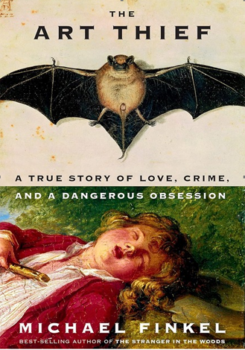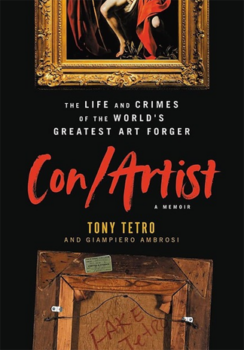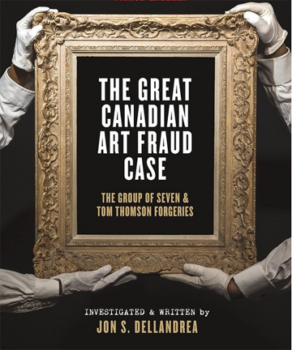Stranger Than Fiction
April 2024
Scam Artists
by Dean Jobb
They came, they stole, they forged, they faked. Three recent true crime books journey into the shadowy world of art thieves and art forgers to expose masterpieces of fraud and deception.
One of the most accomplished art thieves in history never wielded a weapon, overpowered a security guard, or wore a mask. Most of his thefts were spur-of-the-moment affairs, executed in broad daylight and with amazing speed and dexterity. And he lived in the attic of his mother’s home in France. In this modest two-room suite, Stéphane Breitwieser displayed paintings—mostly the work of celebrated sixteenth- and seventeenth-century masters—exquisite ivory carvings, vintage weapons, and goblets and other examples of fine silverwork. The cache was worth an estimated $2 billion, but Breitwieser never tried to sell a single piece. He stole solely to satisfy his insatiable appetite to possess beautiful things.
 Best-selling author Michael Finkel chronicles Breitwieser’s strange crimes of passion in The Art Thief: A True Story of Love, Crime, and a Dangerous Obsession (Alfred A. Knopf), a tour de force of meticulous research and can’t-put-it-down storytelling. “Art is my drug,” Breitwieser told Finkel in one of many interviews, after the author tried for years to gain the thief’s trust and cooperation. Breitwieser swiped his first piece, a three hundred-year-old flintlock pistol, from a museum near his home in the Alsace region of eastern France in 1994, when he was just twenty-two. If the beauty or fine workmanship of a piece in a display case or depicted in an art book or museum brochure caught his eye, he could rarely resist the urge to add it to his collection. It was, in the words of one French journalist, “the biggest pillage of art since the Nazis.”
Best-selling author Michael Finkel chronicles Breitwieser’s strange crimes of passion in The Art Thief: A True Story of Love, Crime, and a Dangerous Obsession (Alfred A. Knopf), a tour de force of meticulous research and can’t-put-it-down storytelling. “Art is my drug,” Breitwieser told Finkel in one of many interviews, after the author tried for years to gain the thief’s trust and cooperation. Breitwieser swiped his first piece, a three hundred-year-old flintlock pistol, from a museum near his home in the Alsace region of eastern France in 1994, when he was just twenty-two. If the beauty or fine workmanship of a piece in a display case or depicted in an art book or museum brochure caught his eye, he could rarely resist the urge to add it to his collection. It was, in the words of one French journalist, “the biggest pillage of art since the Nazis.”
Breitwieser preyed on small museums in small communities, which also had small budgets for security measures and could afford to deploy few guards or surveillance cameras. He showed up during visiting hours, blended in with the tourists doing the rounds of exhibits, and invariably left with a prized piece he had come for or had fallen in love with on the spot. He worked fast, removing paintings from their frames or loosening screws of display cases in the brief moments when a room was empty. He tucked pieces under his coat or into a knapsack and walked out, a phantom in plain sight. An accomplice aided most of these brazen heists—his girlfriend, Anne-Catherine Kleinklaus, acted as lookout, alerting him if patrolling guards or visitors were about to enter a room as he worked his magic.
It was hours and sometimes days before missing items were noticed, and by then no one could remember much about the well-dressed young couple who had been among the many recent visitors. Breitwieser’s approach was a real-life version of a classy heist movie. “Crime works best, he says, not with overpowering force but when nobody knows it’s being committed,” Finkel writes. “In a museum he often thinks of himself as a hunter, camouflaged behind stylish clothes.”
Breitwieser’s success was the product of more than skill and daring. Most art thieves are caught when they try to sell their loot; by keeping his haul, he kept himself under the radar of the police. “There’s almost never been a criminal who knew about or cared about art,” notes one expert on art crimes, and Breitwieser is one of these rare exceptions. He studied art, savored art, and like a junkie lived for the moment he laid his hands on the next piece he coveted. He considered his selfish crimes a form of borrowing—he would enjoy the images and objects but they would outlive him and, someday, would once again be on public display. What he failed to foresee was being caught and what might happen to his collection if he was locked up when the police went hunting for his stash. In this immersive and fascinating account, Finkel charts the rise, fall, and tragic legacy of a man whose obsession destroyed much of the beauty he loved.
 People in the Los Angeles area who knew Tony Tetro in the 1970s and early 1980s were convinced he was a drug dealer. How else, they reasoned, could a man who was still in his twenties—and did not seem to work for a living—afford to drive around town in a sleek Ferrari, an even sleeker Lamborghini, and a Rolls Royce? Their hunch, it turned out, was close to the truth. Tetro was feeding an addiction, but not to drugs. He was making easy money—and plenty of it—by supplying forged works of art to galleries willing to look the other way and collectors with empty walls to fill.
People in the Los Angeles area who knew Tony Tetro in the 1970s and early 1980s were convinced he was a drug dealer. How else, they reasoned, could a man who was still in his twenties—and did not seem to work for a living—afford to drive around town in a sleek Ferrari, an even sleeker Lamborghini, and a Rolls Royce? Their hunch, it turned out, was close to the truth. Tetro was feeding an addiction, but not to drugs. He was making easy money—and plenty of it—by supplying forged works of art to galleries willing to look the other way and collectors with empty walls to fill.
Tetro, who ranks among the most prolific and successful art forgers of all time, tells his remarkable story of making-it-by-faking-it in Con/Artist: The Life and Crimes of the World’s Greatest Art Forger (Hachette Books), cowritten with investigative reporter and documentary filmmaker Giampiero Ambrosi. He’s the most unlikely forged-art mastermind. Born in a small town in upstate New York—ironically, the son of a house painter—Tetro was married and a father at seventeen and sold furniture or hustled dupes in pool halls to make ends meet until he discovered a passion for fine art. He taught himself to draw and paint like his artistic heroes and developed a new hustle, one far more lucrative than clearing billiard tables.
He made flawless copies of Salvador Dali prints and painted original works in the style of great masters such as Picasso, Miro, Chagall, and Rembrandt. Tetro made annual pilgrimages to Europe to try his luck at the casinos of Monaco and to stock up on the vintage canvasses, paper, and paints he needed to fool art experts. He pored over art books as he honed his techniques and dreamed up plausible provenances. To add patina to freshly painted works, he sometimes applied a brownish sludge—the product of cigarette butts extinguished in the dregs of a coffee cup. When he needed the paint to appear cracked with age, he popped the canvas in a pizza oven overnight. “Forgery was fun,” he notes, “like a challenging puzzle or a riddle to solve.”
He made millions of dollars over the years and “Tetros” would one day be found among the collections of the future King Charles III. It was a wild, drug-fueled life while it lasted—he hung out at the same bars and restaurants as Hollywood celebrities—until he forged one artist too many. He was arrested in 1989, soon after the Japanese artist Hiro Yamagata spotted one of his fakes as he strolled past an LA gallery. He served a mere nine months of community service for his crimes, painting traffic-safety posters and teaching art to school kids as penance.
Readers of this chatty, tell-all memoir will be astounded not only by how easily buyers were fooled, but by how many people were complicit in his frauds. Gallery owners and art dealers, he insists, knew the works he peddled were fakes. When he approached them with a piece he claimed was a family heirloom, “they didn’t ask me, ‘Do you also have Chagall,’” he claims. “They asked, ‘Do you also do Chagall.’”
 A decade before Tetro began to mimic Dali and other masters, Canada was rocked by a forged-artwork scandal. The market was flooded with paintings by the country’s premier artists, collectively known as the Group of Seven, who produced distinctive, stylized and abstract depictions of landscapes and rugged wilderness. Problem was, there were far more canvases in galleries and on the walls of wealthy collectors than the trailblazing artists had ever produced in their 1920s heyday.
A decade before Tetro began to mimic Dali and other masters, Canada was rocked by a forged-artwork scandal. The market was flooded with paintings by the country’s premier artists, collectively known as the Group of Seven, who produced distinctive, stylized and abstract depictions of landscapes and rugged wilderness. Problem was, there were far more canvases in galleries and on the walls of wealthy collectors than the trailblazing artists had ever produced in their 1920s heyday.
The extent of the fraud exploded into public view during a Toronto art auction in 1962, when a respected newspaper critic, Elizabeth Kilbourn, stood up and accused one of the country’s most respected art dealers of peddling fakes. “Where do these pictures come from?” she asked. It was up to buyers to inspect paintings before bidding on them, the dealer insisted. “An auctioneer’s job is to sell what is sent to him,” dismissing Kilbourn and a bidder who also questioned the authenticity of the paintings as “Communists,” perhaps the worst insult anyone could muster in the midst of the Cold War.
As it turned out, the province of Ontario’s police force had just launched a major investigation to ferret out the artists and dealers who were churning out the fakes—so many, in fact, that there were fears that the market for authentic Group of Seven works would collapse.
Toronto art collector-turned-art sleuth Jon S. Dellandrea, a former university administrator, recounts this episode in art history in The Great Canadian Art Fraud Case: The Group of Seven & Tom Thomson Forgeries (Goose Lane Editions). When demand for works of well-known artists exceeds supply, as was the case in the early 1960s, he notes, “an increase in forgeries is almost always the likely response.”
Dellandrea twigged to the forgotten fraud in 2016, when he spotted a fake painting attributed to a well-known artist in an auction-house catalogue. He knew it was not the real thing because he owned a miniature version of the painting, only his was produced by an obscure 1920s artist named William Firth MacGregor. He put on his Sherlock Holmes deerstalker, amassed an impressive dossier on both the elusive MacGregor and the 1960s police investigation, which culminated in prosecution of two Toronto art dealers for fraud. One member of the Group of Seven served as an advisor to the police while another, A.Y. Jackson, testified against the dealers. “It’s big and bad and I did not paint it,” he declared from the witness stand when shown a painting bearing his forged signature.
While MacGregor had painted many of the fakes, he had been an unwitting accomplice—like many other artists, he had painted in the style of the successful Group of Seven. He had sold his works for a pittance and others had applied famous signatures to his work, creating the fakes. One of Dellandrea’s goals was to rescue MacGregor from obscurity, a mission he has accomplished.
The Great Canadian Art Fraud Case is lavishly illustrated with color reproductions of paintings both real and fake, many of them drawn from Dellandrea’s personal collection, as well as news photographs that document the police investigation and the scores of fake paintings displayed as evidence in the courtroom.
“I was shocked to learn just how much forged art is still circulating in the Canadian art market,” the author notes. As the embattled Toronto auctioneer noted six decades ago, when it comes to fine art, it’s often a case of buyer beware.
———
Dean Jobb’s next book, A Gentleman and a Thief: The Daring Jewel Heists of a Jazz Age Rogue (Algonquin Books), will be released in June. It’s the incredible true story of Arthur Barry, who charmed the elite of 1920s New York while planning some of the most brazen jewel thefts in history. For more on this and his other true crime books, find him at deanjobb.com.
Copyright © 2024 Dean Jobb
